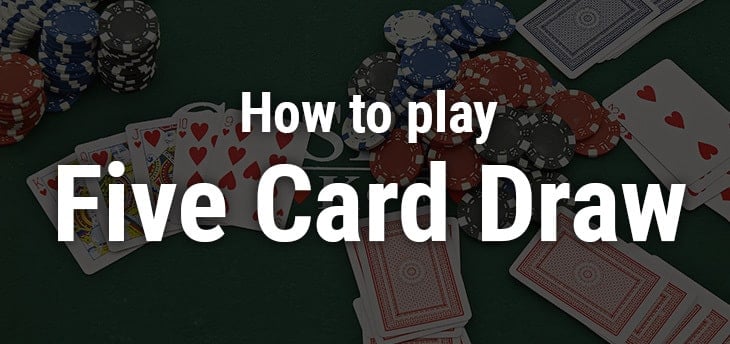Texas Hold’em is the most popular poker variant in the world, and for good reason. It’s a perfect balance between being easy to learn and hard to master, so it appeals to a broad audience. However, playing any form of poker can feel monotonous over time; when that happens, you might not know what to do.
Thankfully, there are many different ways to play poker. If you feel like Hold’em’s strategy can be overwhelming and just want to relax with a simple variant, then Five Card Draw is an excellent choice. We’ll cover everything you need to know, from the game’s history as the leading poker variant to its rules and mechanics.
Whether you’re a Hold’em veteran or a beginner looking to start learning poker, this guide is perfect for you.
Five Card Draw Overview
Five Card Draw was the first form of poker, having arrived in the US from France thanks to the Louisiana Purchase. The game saw numerous improvements, from increasing the number of betting rounds to using a 52-card deck. Soon, it lost its original French name, “poque,” becoming the iconic poker we know today.
Five Card Draw became very popular throughout the US due to the 1861 Civil War. After it ended, soldiers brought the game home, spreading it throughout the Midwest. It remained the dominant form of poker for centuries, up until Seven Card Stud emerged during the early 20th century.
Nowadays, Five Card Draw’s popularity is a fraction of what it once was. The game is still popular for casual home games since it’s very easy to learn, but its lack of depth compared to other variants is why you don’t often see it in casinos or tournaments.

Antes
Five Card Draw uses antes, a common mechanic used to seed a pot with funds prior to the hands being dealt.
The antes are forced bets players must make before getting their cards. The amount of the ante would be determined prior to the start of a game and remain the same throughout. A 6 player $5 five-card draw game would have $30 in the pot prior to the deal.
The blinds exist to discourage hyper-conservative play. In some games, one player would pay the full ante for the table to save time, with the payee would rotate to ensure everyone pays them equally. This added “cost” to playing the game prevents players from waiting until they have a strong hand.
No Limit Betting
Five Card Draw can use any betting format: Fixed-limit, Pot Limit, and No Limit being the most common. However, we’ll focus mostly on No Limit Five Card Draw.
No Limit is the betting format Texas Hold’em uses, and it allows players to raise and bet any amount they can afford. This leads to explosive action and the biggest pots compared to any of the other formats.
Hand Rankings
Poker involves players trying to make the best possible hand. Five Card Draw uses the traditional hand rankings found in nearly every variant of the game, from Hold’em to Omaha to Seven Card Stud.

Five Card Draw: The First Deal
Five Card Draw begins with each player receiving five cards face down. Prior to receiving the cards, each player pays the ante, and the first player to the left of the dealer begins the action.
With the antes paid, the players can take any standard poker action: Check, Bet, Call, Raise, or Fold. Checking means you are taking no action and the action passes to the next player. Betting means putting in an amount that other players will have to at least match if they want to continue in the hand. Calling means matching the previous bet’s exact amount. The action passes to the next player.
Raising means increasing the active bet size and forcing all players to respond to it, even the player who made the first bet. Folding means giving up your cards and leaving the game. If everyone except one player folds, that player wins the hand by default.
After every player has responded to any bets, the round ends and the game moves to its second phase: The drawing round.
The Draw Phase
During the drawing round, players can exchange their cards for new ones to try and improve their hands. They can choose any quantity of cards to discard, drawing an equivalent number from the deck.
There are many variations of Five Card Draw since it’s primarily a home game; different places have their own rules. One of the most common is only being able to draw three cards, forcing players to think carefully about which cards to get rid of.
Players can also choose not to draw and keep their hand as it is, known as “standing pat.” After everyone has drawn or stood pat, the game progresses to its third and final phase: The second betting round.

The Second Betting Round
Five Card Draw only has two total betting rounds, compared to Hold’em’s four. This round doesn’t start with an active bet, allowing players to check or make their own bet. If someone chooses to bet, everyone will have to respond with a call, raise, or fold.
Once the second betting round ends, if two or more players remain in the hand, the showdown occurs. Every remaining player reveals their hand, and the player with the best one wins the pot.
Five Card Draw Variants
If you want more out of your five-card draw experience, you can try slightly changing the rules. One of the most common ways to do this is by adding a “bug,” more commonly known as a wild card, usually represented by a joker.
The bug is a wild card, but only for a few specific circumstances. It can complete a straight, complete a flush, or get used as an ace. Adding a wild card isn’t standard in poker, but it can be a great way to spice up your home games.




